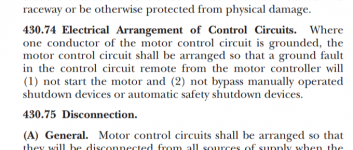donf
Member
- Location
- Tidewater Virginia
Another battle with a student.
If you look at the appended jpeg you will find two schematics for a motor control circuit. “A” is my drawing. I had been taught that you cannot use Neutral as a switched conductor. I believe it is buried somewhere in code, but darned if I can find it. It is my understanding that you bring your L1 through the Overload to the Switches. In the event of an Overload trip, Line 1 voltage is cut to the circuit.
Drawing “B”, brings L1 to the switches and uses Neutral to the Overload. In the event of an Overload, the contacts open and Neutral drops out, opening the circuit. But that is effectively using Neutral as a switched circuit, Is that allowed in the whacky world of motor starters?
In practice, both methods will work. However, I believe that “B” violates the NEC but I cannot prove that statement.
If I were using a transformer for 208 to 24V or even using a 208v coil from the L1 & L2 conductors I don’t think it would really matter since I am not connecting A2 to Neural.
By the way, Article 100’s definition of “Neutral” is silent regarding Neutral as a switched conductor.
If you look at the appended jpeg you will find two schematics for a motor control circuit. “A” is my drawing. I had been taught that you cannot use Neutral as a switched conductor. I believe it is buried somewhere in code, but darned if I can find it. It is my understanding that you bring your L1 through the Overload to the Switches. In the event of an Overload trip, Line 1 voltage is cut to the circuit.
Drawing “B”, brings L1 to the switches and uses Neutral to the Overload. In the event of an Overload, the contacts open and Neutral drops out, opening the circuit. But that is effectively using Neutral as a switched circuit, Is that allowed in the whacky world of motor starters?
In practice, both methods will work. However, I believe that “B” violates the NEC but I cannot prove that statement.
If I were using a transformer for 208 to 24V or even using a 208v coil from the L1 & L2 conductors I don’t think it would really matter since I am not connecting A2 to Neural.
By the way, Article 100’s definition of “Neutral” is silent regarding Neutral as a switched conductor.




